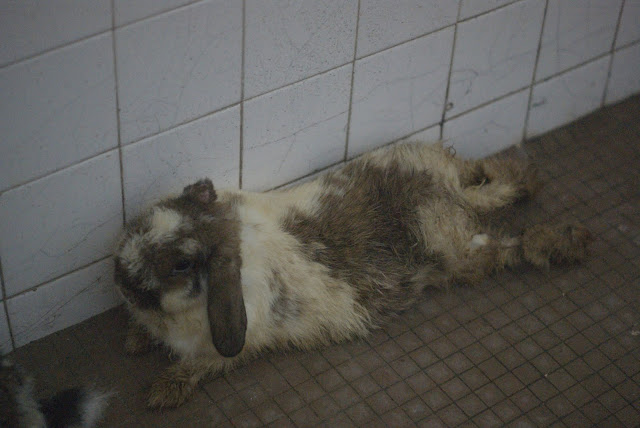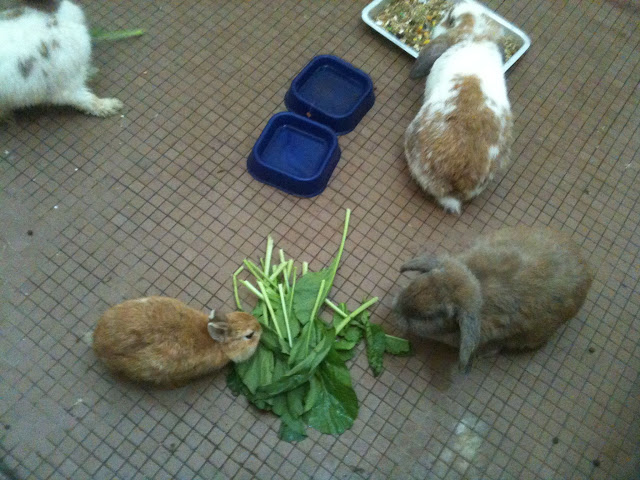Wednesday, July 27, 2011
A free-roaming home-cat...faces MANY dangers that can result in harm or even death!
He was seen drinking water from the drain. Pest controllers frequently spray poisons into drains to prevent mosquito breeding.
He is at risk of being harmed by cat haters and abusers.
He is at risk of running across roads and knocked down by cars.
He is at risk of being rounded up by the town council's pest controller who will send him to be KILLED at the AVA.
So if you really love your cat, KEEP HIM or HER SAFE INDOOR!
Tuesday, July 26, 2011
Monday, July 25, 2011
Saturday, July 23, 2011
Cats - Winning the battle for public opinion

| Time | 29 July · 21:00 - 22:30 |
|---|---|
| Location | Loft, Post-Museum 107+109 Rowell Rd Singapore, Singapore |
| Created by: | |
| More info | We have science, research &, statistics on our side. Now we also have the government on our side. But can we win the heart of the man on the street? Cats - Winning the battle for public opinion is a talk by Veron Lau, Vice-President of Cat Welfare Society, a registered charity that aims to promote a humane, responsible and informed society where cats are cared for responsibly as pets and treated with kindness as community cats. The Society actively promotes sterilisation as a vital personal responsibility of a cat owner and an effective means to control our community cat population, instead of destruction. Veron oversees the education and community outreach arm of the Cat Welfare Society. Part of that role is being a mediator, bridging the disparate expectations of complainants, cat caregivers, Town Council officers and government agencies. This talk is part of Activist Care Centre, a fundraising programme of Post-Museum to mark the closing of the current premises [http://www.facebook.com/ev Please RSVP as seats are limited. Entry by donation to Post-Museum Fund (suggested $10). |
Answer lies in sterilising, not culling

ST Forum
Online Story
Jul 23, 2011
Strays: Answer lies in sterilising, not culling
SEVERAL points were raised by Mr Kammo Liu ("Putting strays to sleep may be the kindest act yet"; last Saturday), including suggesting that cats must be owned, loved and taken care of, otherwise the kindest thing would be to put them down.
As much as these animals are vulnerable to accidents, disease or abuse, there are countless community cats leading happy lives, cared for by many volunteers, who are spurred on by their dedication and commitment to help the animals.
The Society for the Prevention of Cruelty to Animals hopes that the current HDB rule on prohibition of cats will be reversed, and that all pet cats will be required to be microchipped, sterilised and kept indoors. Microchipping (as is the case for pet dogs) would ensure owners stay accountable in the event anyone abandons his pet.
Contrary to the statement that culling stray dogs reduced the problem to zero, there is still a significant population of stray dogs existing. Many are still being rescued and cared for by individuals or dedicated animal welfare groups, and some are more fortunate in that they do find loving homes to spend the rest of their days in.
With the Stray Cat Sterilisation Programme being resurrected and carried out in several constituencies, more animals can now have a second chance at life - yes, there will be hurdles to overcome, but with the cooperation and understanding of the community at large, we think it can succeed.
Culling as a means of solving the overpopulation of strays has already been carried out for decades, but the evidence from statistics proves that it has not been effective. In recent years, the number of stray cats has steadily been decreasing, and we attribute this to individual and animal groups' efforts to sterilise our community cats. Admittedly it is not an overnight solution, but sterilisation addresses the root cause - prolific breeding. With widespread efforts to arrest the births, it is a matter of time before the population will dwindle.
Deirdre Moss (Ms)
Executive Director
Society for the Prevention of Cruelty to Animals
Wednesday, July 20, 2011
Tuesday, July 19, 2011
Good move to set up animal task force

http://www.straitstimes.com/STForum/OnlineStory/STIStory_691962.html
Jul 19, 2011
Good move to set up animal task force
LESS than a month after the first public forum on animal welfare policies in Singapore was held, the Ministry of National Development (MND) announced last Monday that it plans to form an inter-agency task force to review current pet ownership and stray animal management policies ('Task force to review pet ownership policies'; last Tuesday).
This is testament to the success of the forum organised by the Animal Concerns Research & Education Society, as well as MND's leadership in addressing public concerns by constructive dialogue.
The review will involve different stakeholders, from senior MND officials to residents. This is a departure from the way policies were developed and represents a move towards public engagement and more informed policymaking.
The review's ultimate objective of creating 'a conducive shared living environment for everyone' also shows MND's appreciation of the role animals - strays or pets - play towards a happier and more liveable society.
The inability of animals to communicate their suffering in words imposes on humans a higher moral obligation to discern their cries for help.
Mahatma Gandhi once said that the true nature of a community is revealed in the way it treats its animals. MND's commitment to have an extensive review of pet ownership and stray animal management policies represents a positive step.
Daisy Chee (Ms)
Saturday, July 16, 2011
Thursday, July 7, 2011
1st Training Session for Chong Pang Volunteers
| Time | 09 July · 14:00 - 17:00 |
|---|---|
| Location | Chong Pang Community Centre, Auditorium, 3rd Level 21 Yishun Ring Road Singapore 768677 |
| Created by: | |
| More info | Help achieve NO CULLING of community cats in Singapore! Together, we can implement a model Responsible Cat Management Programme in Chong Pang to achieve 1) Stabilised numbers of community cats 2) Effective resolution of complaints 3) No-culling of community cats. We will make this happen through 1) A door-to-door engagement with residents of Chong Pang through a survey and with education 2) Responsible caregiving with designated volunteers, legitimised feeding stations and effective resolution of cat-related complaints The programme for the training is as follows: 1.30pm Reception & Networking (30min) 2.00pm Orientation of the Responsible Cat Management Programme including SCSP SOP (30min) - CWS 2.30pm Mediation and engagement skills (45min) - CWS 3.15pm Assisting in abuse investigations (30min) - SPCA 3.45pm Cat trapping using a humane cat trap (45 min with live demo) - Mutts & Mittens Foundation 4.30pm Q & A 5.00pm End See you there at this important moment in history! |
Wednesday, July 6, 2011
Stop Such Abuse!!

https://www.facebook.com/photo.php?fbid=241864839175997&set=a.241864835842664.74834.100000574483388&type=1&theater
The cat's version of this story
 "She was frightened by a dog and kicked by the dog owner. The cat bites that dog owner in self defence. She was provoked."
"She was frightened by a dog and kicked by the dog owner. The cat bites that dog owner in self defence. She was provoked."Mu Lao Hu
读了此报告《狗主护犬遭野猫扑咬》后,我也读了Mett
这只猫原本是只宠物猫。猫主并没有把猫结扎,却把猫儿在
后来,这只猫儿因寻找食物而被其他的流浪猫追逐,无奈地
其实,狗主如果把他们的宠物狗系好,不让狗儿接近猫儿的
恳请读者们,见到邻里的流浪猫时,请不要去骚扰或恐吓猫
如果读者想反应他区内邻里猫的问题的话,请与猫福利协会

Sunday, July 3, 2011
Nine Abandoned Rabbits in Tampines
Nine Abandoned Rabbits in Tampines
July 2, 2011 at 4:54 pm | Posted in Animal Abuse, Animal Rescue, Animal Rights | Leave a commentLucky 9 rabbits, unlucky rescuer. At around 12 midnight, near the 400+ blocks of Tampines Ave 9, 9 badly abused pedigree rabbits were found at the foot of a void deck, squeezed like sardines in a rusty 2-feet cage.
Suspected to be a home breeder’s hordes, these rabbits have probably been living in torture their whole lives. One with a missing ear, another with a head tilt so bad that it couldn’t even sit or stand upright, and all sneezing away. They are skinny, dirty and they have probably never seen sunlight.
This is the year of the rabbit and is this how rabbits should be treated? These poor rabbits are probably lucky to have been saved, I guess.
Thankfully, with the help of volunteers from House Rabbit Society of Singapore (HRSS), 3 were rushed to the vet the next day. We are asking for appeal to help HRSS with the medical and sterilisation costs of these rabbits. If you are able to give them a home, please contact Lynn at crystal.chakra@gmail.com. Any amount of donation is welcomed and all funds will be channeled to HRSS to help this lot of rabbits.
All rabbits are pedigree breed: Lop ear rabbits, Lion Head, Dwarve Rabbits.
Rabbit with missing ear
Rabbit with tilted head

Hungry rabbits:

Here’s the album of all the rabbits:
 |
| Abandoned Rabbits |
Saturday, July 2, 2011
Friday, July 1, 2011
Why Pets Are Therapeutic
Pets are great for kids as well as they are growing pets can help a child have better social skills. Most children who have a child in their home between the ages of 1-6 will develop better social skills, coordination and less likely to suffer from pet allergies as they grow older.
A pet can give you unconditional love and support. Pets don't talk back or argue. They won't talk behind your back or leave you for someone else. Pets often form strong bonds with their owners and will be loyal to the end. They can help calm a person down naturally without the use of medication. Just by petting an animal or playing you can relieve tension and calm your nerves.
Additional health benefits of why animals are therapeutic for kids and adults are they bring smiles to everyone. With this studies have shown it increases a person’s immune response and children help build children’s response to immunity from pet allergies.








